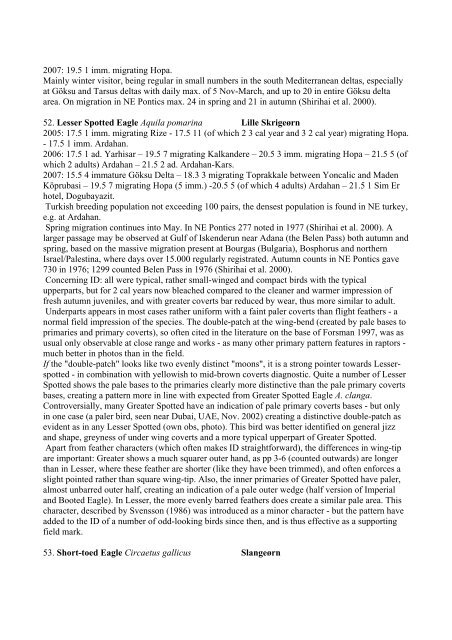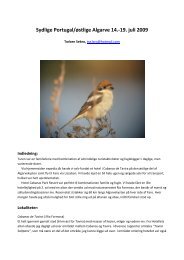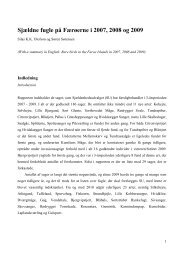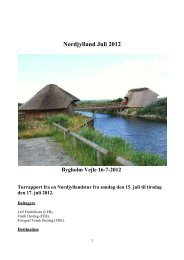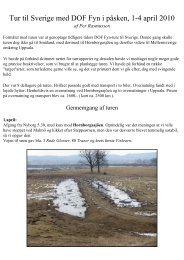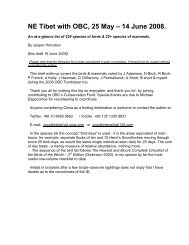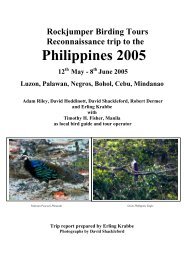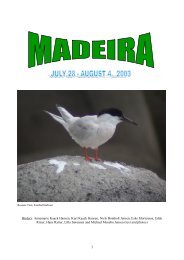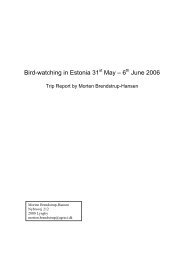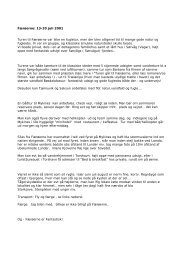TURKEY - a report from a birdwatching trip to Central ... - Netfugl.dk
TURKEY - a report from a birdwatching trip to Central ... - Netfugl.dk
TURKEY - a report from a birdwatching trip to Central ... - Netfugl.dk
You also want an ePaper? Increase the reach of your titles
YUMPU automatically turns print PDFs into web optimized ePapers that Google loves.
2007: 19.5 1 imm. migrating Hopa.<br />
Mainly winter visi<strong>to</strong>r, being regular in small numbers in the south Mediterranean deltas, especially<br />
at Göksu and Tarsus deltas with daily max. of 5 Nov-March, and up <strong>to</strong> 20 in entire Göksu delta<br />
area. On migration in NE Pontics max. 24 in spring and 21 in autumn (Shirihai et al. 2000).<br />
52. Lesser Spotted Eagle Aquila pomarina Lille Skrigeørn<br />
2005: 17.5 1 imm. migrating Rize - 17.5 11 (of which 2 3 cal year and 3 2 cal year) migrating Hopa.<br />
- 17.5 1 imm. Ardahan.<br />
2006: 17.5 1 ad. Yarhisar – 19.5 7 migrating Kalkandere – 20.5 3 imm. migrating Hopa – 21.5 5 (of<br />
which 2 adults) Ardahan – 21.5 2 ad. Ardahan-Kars.<br />
2007: 15.5 4 immature Göksu Delta – 18.3 3 migrating Toprakkale between Yoncalic and Maden<br />
Köprubasi – 19.5 7 migrating Hopa (5 imm.) -20.5 5 (of which 4 adults) Ardahan – 21.5 1 Sim Er<br />
hotel, Dogubayazit.<br />
Turkish breeding population not exceeding 100 pairs, the densest population is found in NE turkey,<br />
e.g. at Ardahan.<br />
Spring migration continues in<strong>to</strong> May. In NE Pontics 277 noted in 1977 (Shirihai et al. 2000). A<br />
larger passage may be observed at Gulf of Iskenderun near Adana (the Belen Pass) both autumn and<br />
spring, based on the massive migration present at Bourgas (Bulgaria), Bosphorus and northern<br />
Israel/Palestina, where days over 15.000 regularly registrated. Autumn counts in NE Pontics gave<br />
730 in 1976; 1299 counted Belen Pass in 1976 (Shirihai et al. 2000).<br />
Concerning ID: all were typical, rather small-winged and compact birds with the typical<br />
upperparts, but for 2 cal years now bleached compared <strong>to</strong> the cleaner and warmer impression of<br />
fresh autumn juveniles, and with greater coverts bar reduced by wear, thus more similar <strong>to</strong> adult.<br />
Underparts appears in most cases rather uniform with a faint paler coverts than flight feathers - a<br />
normal field impression of the species. The double-patch at the wing-bend (created by pale bases <strong>to</strong><br />
primaries and primary coverts), so often cited in the literature on the base of Forsman 1997, was as<br />
usual only observable at close range and works - as many other primary pattern features in rap<strong>to</strong>rs -<br />
much better in pho<strong>to</strong>s than in the field.<br />
If the "double-patch" looks like two evenly distinct "moons", it is a strong pointer <strong>to</strong>wards Lesserspotted<br />
- in combination with yellowish <strong>to</strong> mid-brown coverts diagnostic. Quite a number of Lesser<br />
Spotted shows the pale bases <strong>to</strong> the primaries clearly more distinctive than the pale primary coverts<br />
bases, creating a pattern more in line with expected <strong>from</strong> Greater Spotted Eagle A. clanga.<br />
Controversially, many Greater Spotted have an indication of pale primary coverts bases - but only<br />
in one case (a paler bird, seen near Dubai, UAE, Nov. 2002) creating a distinctive double-patch as<br />
evident as in any Lesser Spotted (own obs, pho<strong>to</strong>). This bird was better identified on general jizz<br />
and shape, greyness of under wing coverts and a more typical upperpart of Greater Spotted.<br />
Apart <strong>from</strong> feather characters (which often makes ID straightforward), the differences in wing-tip<br />
are important: Greater shows a much squarer outer hand, as pp 3-6 (counted outwards) are longer<br />
than in Lesser, where these feather are shorter (like they have been trimmed), and often enforces a<br />
slight pointed rather than square wing-tip. Also, the inner primaries of Greater Spotted have paler,<br />
almost unbarred outer half, creating an indication of a pale outer wedge (half version of Imperial<br />
and Booted Eagle). In Lesser, the more evenly barred feathers does create a similar pale area. This<br />
character, described by Svensson (1986) was introduced as a minor character - but the pattern have<br />
added <strong>to</strong> the ID of a number of odd-looking birds since then, and is thus effective as a supporting<br />
field mark.<br />
53. Short-<strong>to</strong>ed Eagle Circaetus gallicus Slangeørn


